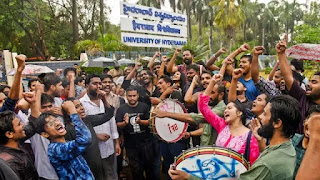 |
| source |
At the heart of the issue is a 400-acre patch of forested land — a rare green lung in the middle of Hyderabad’s expanding Financial District — that the state government plans to auction for the development of IT parks. But what began as a routine urban development plan has now escalated into a legal, ecological, and civic standoff.
What Makes Kancha Gachibowli Special?
Kancha Gachibowli is one of the last remaining urban forests in Hyderabad. Situated beside the University of Hyderabad (UoH), this green expanse hosts a vibrant ecosystem of bird, mammal, and reptile species, many of which fall under protected categories. It also features stunning ancient rock formations, including the popular ‘Mushroom Rock’.
Environmentalists stress that such forests moderate urban climates, absorb pollution, and serve as natural carbon sinks — essential for a city grappling with increasing concrete sprawl and heat islands.
 |
| source |
Student Protests and the Rise of #SaveKanchaGachibowli
Ever since the Telangana government announced its auction plan in February 2024, students from UoH and activists have launched a vigorous protest campaign. Rallies, sit-ins, and social media drives under the hashtag #SaveKanchaGachibowli have become increasingly visible.
Groups like Save City Forest, comprising nature lovers and wildlife enthusiasts, have also joined the fight, raising alarms about the absence of an Environmental Impact Assessment (EIA) or any wildlife clearance — both of which are mandatory under Indian law if endangered species are involved.
What the Government Says
The Telangana government maintains that the land lies within Hyderabad’s lucrative Financial District, and developing it could bring ₹50,000 crore in investments and create up to 5 lakh jobs.
The Telangana Industrial Infrastructure Corporation (TGIIC) has stated that their layout plan retains green zones and conserves natural features like rock formations. They argue that the development is essential for Hyderabad's growing IT infrastructure.
Legal Grey Zones and Land Ownership
Legally, the state government is the rightful owner of the 400 acres. The land was originally part of a 2,300-acre parcel allotted to UoH in 1974, but multiple re-allocations have chipped away at this area over decades.
Interestingly, in 2003, the then-united Andhra Pradesh government leased this land to a private sports management firm, which failed to use it, leading the state to reclaim it in 2006. The move triggered a lengthy legal battle, eventually leading the Supreme Court to reaffirm that the Telangana government retains ownership.
However, the land has never been formally demarcated or notified as a forest — despite being visibly forested and ecologically integrated into UoH’s ecosystem. This ambiguity is central to the current legal and moral debate.
Citing the Godavarman Case
Protestors are now citing the Supreme Court’s landmark 1996 verdict in T N Godavarman Thirumulpad v Union of India. The ruling held that any land with forest characteristics qualifies as “forest land”, even if it isn’t officially notified as such.
This interpretation brings the Kancha Gachibowli forest under the purview of environmental and wildlife protection laws — meaning that clearing it without legal environmental clearances could be illegal.
What’s Next?
With the Supreme Court stepping in, deforestation has been paused for now. But the long-term future of Kancha Gachibowli remains uncertain. The case has ignited a wider conversation about urban planning, ecological responsibility, and legal reform in India’s rapidly growing cities.
For many in Hyderabad, the fight is not just about saving a forest — it’s about rethinking what development should look like in a climate-stressed world.




No comments:
Post a Comment